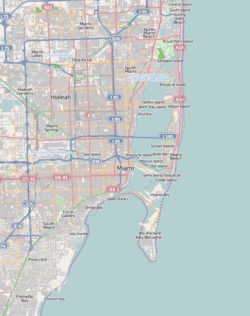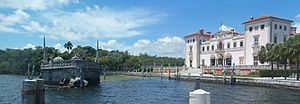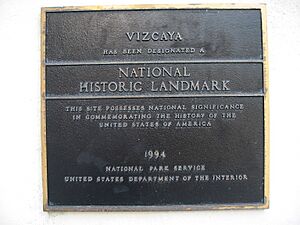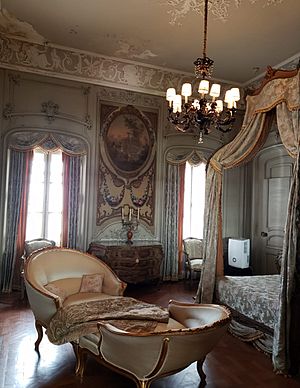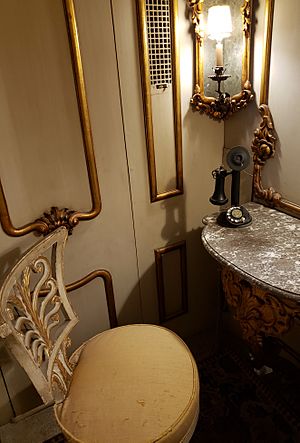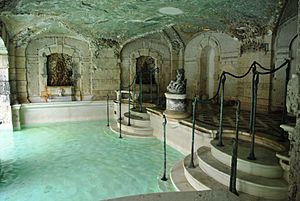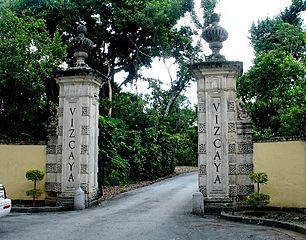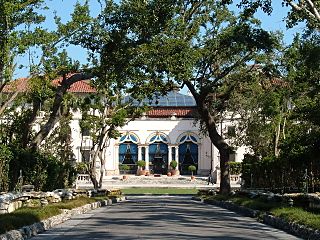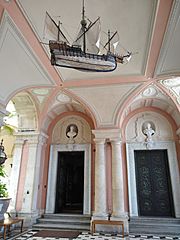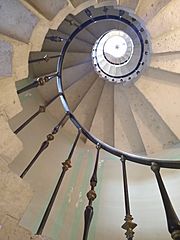Vizcaya Museum and Gardens facts for kids
|
Vizcaya
|
|
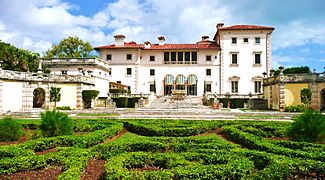
Vizcaya Museum and Gardens in February 2011
|
|
| Location | 3251 South Miami Avenue Miami, Florida, U.S. |
|---|---|
| Area | 43 acres (17 ha) |
| Built | 1914–23 |
| Architect | F. Burrall Hoffman (architect), Paul Chalfin (designer), and Diego Suarez (landscape architect) |
| Architectural style | Mediterranean Revival Style; with Baroque, Italian Renaissance, Italian Renaissance Revival |
| NRHP reference No. | 70000181 (original) 78003193 (increase) |
Quick facts for kids Significant dates |
|
| Added to NRHP | September 29, 1970 |
| Boundary increase | November 15, 1978 |
| Designated NHLD | April 19, 1994 |
The Vizcaya Museum and Gardens is a beautiful old estate in Miami, Florida. It used to be the winter home of a rich businessman named James Deering. He made his money from the International Harvester company.
This amazing place sits right on Biscayne Bay in the Coconut Grove area. It includes a grand house, huge Italian Renaissance style gardens, and even a historic village.
The design of Vizcaya was inspired by old Italian buildings and gardens. It mixes styles like Mediterranean Revival architecture and Baroque architecture. F. Burrall Hoffman was the main architect. Paul Chalfin was the design director, and Diego Suarez created the beautiful gardens.
Today, Miami-Dade County owns Vizcaya. It is now a museum and garden that everyone can visit. You can even get there by Miami Metrorail at the Vizcaya Station.
Contents
What's in a Name?
The name "Vizcaya" comes from a region in northern Spain called Biscay. This area is next to the Bay of Biscay in the Atlantic Ocean. Since the estate is on Biscayne Bay in the Atlantic, the name made sense.
James Deering also wanted the name to honor an early Spanish explorer. He thought the explorer's name was Vizcaya. Later, he learned the explorer's name was actually Sebastián Vizcaíno.
Deering chose a caravel ship as Vizcaya's special symbol. Caravels were ships used during the Age of Exploration. A statue of a mythical explorer, "Bel Vizcaya," greets visitors at the estate's entrance.
A Look Back in Time
The land where Vizcaya stands was once a large area of 180 acres (73 ha). It had thick mangrove wetlands and tropical forests. James Deering was a conservationist. He built the estate along the shore to protect the beautiful forests.
The estate included the main house, formal gardens, and a small village for services. Deering started building Vizcaya in 1912. He officially moved in on Christmas Day in 1916, arriving on his yacht, the Nepenthe.
The main house was mostly built between 1914 and 1922. The amazing Italian Renaissance gardens and village were finished by 1923. Deering used Vizcaya as his winter home until he passed away in 1925.
Vizcaya is special because it blends old European styles with South Florida's subtropical climate. For example, it has French and Italian garden designs. These are made with Cuban limestone and Florida coral. The gardens are filled with plants that grow well in Florida, like palms and philodendrons. These plants were not found in the original European gardens that inspired Vizcaya.
In 1910, James Deering met Paul Chalfin, an art expert and designer. Chalfin became the project's director. He helped Deering collect art and old items for the estate. Chalfin also suggested F. Burrall Hoffman as the architect for the main house and other buildings.
In 1914, Deering and Chalfin met Diego Suarez, a landscape designer. Suarez created the master plan for Vizcaya's gardens. He first planned a garden like a 16th-century Italian villa. But he changed his mind to an Italian Renaissance style that fit the land better.
Suarez and Chalfin worked together on the garden's decorations. They used old trees, vines, coral stone sculptures, and antiques to make the garden look aged. Suarez made an artificial hill, called the garden mound, the main focus. Around it, he created different "rooms" like the Secret Garden and the Fountain Garden. Each area has unique plants and decorations.
The outside of Vizcaya's house and gardens combine ideas from many Italian and French Renaissance villas. The main house design was inspired by the Villa Rezzonico in Italy. Some people even call Vizcaya the "Hearst Castle of the East."
Vizcaya also had very modern technology for its time. It had old doorbells, a dumbwaiter (a small elevator for food), and a rotary-dial telephone. Vizcaya's telephone system was the first in Miami-Dade County!
James Deering passed away in 1925. His two nieces inherited Vizcaya. Over time, after hurricanes and high costs, they started selling parts of the estate. In 1945, they sold a large section to build Mercy Hospital. About 50 acres (200,000 m2) with the main house, gardens, and village were kept.
In 1952, Miami-Dade County bought the house and gardens for $1 million. Deering's family gave the county all the furniture and art inside the house. Vizcaya opened as the Dade County Art Museum in 1953. The rest of the property, including the village, was bought by the county later. In 1994, Vizcaya became a National Historic Landmark.
A Robbery in 1971
On March 22, 1971, some valuable artworks and silver items were stolen from Vizcaya. The police quickly caught three people from New York City a few days later. About $250,000 worth of the stolen items were found in their apartment. One of the stolen items was a very valuable silver bowl that once belonged to Napoleon Bonaparte. Sadly, most of the precious items stolen from Vizcaya were never found.
Exploring Vizcaya Museum and Gardens
Today, Vizcaya Museum and Gardens covers 50 acres (200,000 m2). This includes the main house, 10 acres (40,000 m2) of beautiful Italian Renaissance formal gardens, and 40 acres (160,000 m2) of native forest. It's a place full of unique decorations and lots of history. You can take an audio tour to explore the mansion and its surroundings. There are many hidden spots to discover, making it a great place to spend hours.
The museum inside the house has over seventy rooms. They are filled with amazing art and furniture from 15th to early 19th-century Europe. Some of the ceramics were originally shipped from England in 1912 but sank with the Titanic. Luckily, Deering had insurance and got them replaced!
Vizcaya was built with an open-air courtyard and large gardens right on Biscayne Bay. This means it has faced damage from nature, especially hurricanes. Big hurricanes hit in 1926, 1992, and 2005. Miami-Dade County has given money to help restore and protect Vizcaya. Other groups like FEMA have also helped.
Plans include fixing up the house and gardens. They also want to turn the historic village into places for exhibits and learning. The museum has already rebuilt its cafe and shop. They also renovated the gate lodges and rebuilt the David A. Klein Orchidarium. Vizcaya has also been working to restore its outdoor sculptures.
The Great Miami Hurricane of 1926 caused a lot of damage to Vizcaya. The historic rose garden was destroyed when saltwater flooded it. Vizcaya's garden team is now working with the Tropical Rose Society of Miami to bring some roses back. The old rose garden, now called the fountain garden, is slowly being restored.
One special outdoor project is the estate's swimming pool grotto, built in 1916. This pool is one of only two public places in the world with a surviving mural by Robert Winthrop Chanler. The ceiling mural, designed in 1916, shows an underwater fantasy with sea creatures. Shells are even pressed into the plaster mural.
In 1992 and 2005, hurricanes flooded the swimming grotto. The floods and Miami's climate make it hard to preserve the mural. The State of Florida has given Vizcaya a grant to help prevent future damage.
In 2008, the National Trust for Historic Preservation listed Vizcaya as one of America's most endangered historic places. This was because tall buildings were planned to be built nearby. These buildings would have blocked the historic views from Vizcaya. Luckily, these plans were stopped by court rulings. In 2010, the City of Miami added rules to protect views from historic places like Vizcaya.
The museum also hosts events to raise money for its preservation. For example, every Halloween, Vizcaya has a costume party. People from all over Florida come dressed up.
Vizcaya also takes part in Baynanza, a day to clean up Biscayne Bay. This event helps protect South Florida's important ecosystem. During Baynanza, Vizcaya holds a photography contest to capture the bay's beauty. This usually happens on Earth Day.
Important Events at Vizcaya
Vizcaya has hosted some very important events.
- In 1987, President Ronald Reagan welcomed Pope John Paul II to Miami at Vizcaya. This was the Pope's first visit to the city.
- In 1994, President Bill Clinton held the first 'Summit of the Americas' at Vizcaya. Leaders from thirty-four nations met there. They created the 'Free Trade Area of the Americas (FTAA)'. This agreement aimed to help countries in the Americas, except Cuba, with trade.
Accessibility at Vizcaya
Vizcaya was a very modern house for its time. It was built with strong concrete and had new technology like generators and a water filter. It also had heating, ventilation, two elevators, and a central vacuum system.
However, Vizcaya was built a long time ago. While it has an old residential elevator, it is not open to the public. Because of its historic design, Vizcaya does not fully meet modern accessibility standards for people with disabilities.
Gallery
See also
 In Spanish: Villa Vizcaya para niños
In Spanish: Villa Vizcaya para niños


